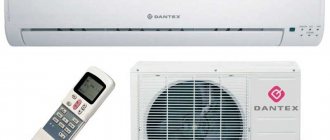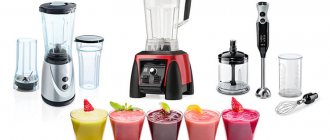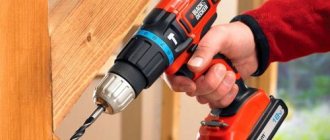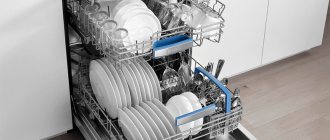Some consider the mixer to be a relic, mistakenly believing that it can be replaced by a blender. Meanwhile, a mixer can be an excellent kitchen assistant. He is able to puree fruits, beat any dough, cream, or transform various ingredients into a homogeneous mixture. And if a food processor with a blender costs a pretty penny, then even a “sophisticated” mixer will come out much cheaper. Today’s guide will teach you how to choose this kitchen unit correctly, without overpaying for unnecessary functionality.
What types of home mixers are there?
Mixing devices can be manual, stationary, with a bowl, planetary, for cocktails and their hybrids. There are universal high-power options, which include accessories for all types of products, a stationary platform, containers for dough and cocktails.
Hand mixer
This is a small-sized, lightweight device for whipping and mixing products. A small motor is housed in a compact plastic case. The mounts for the beaters, which are driven by rotation, are brought out from the casing. There is a button to turn on and select a mode (or smooth speed control). Operates from a general power supply network. The set includes 2-4 pairs of attachments. The owner has 5-7 speed modes to choose from. To get started, two identical attachments are attached to the body, and the power cord is connected to the outlet. Then select a mode and press the start button or switch. Power is usually from 300 to 500 watts. Housewives call the advantages of a manual device:
- ease of use;
- ease of care;
- Compact and easy to store.
Mixer with bowl
Looks like a manual analogue on a stand. A removable vessel with a volume of 3-8 liters is attached to the bottom of the stand. The top part of the device folds down. It also has a choice of paired attachments for whipping or kneading. Buttons for turning on and regulating power or selecting speed are conveniently located on the device body. Electronic or mechanical control panel. It is convenient to knead the dough by setting the regulator to long operation. Material of manufacture: plastic or stainless steel. Metal models are more reliable, but more expensive. In stationary devices, the choice of equipment is wider than in manual ones. The kit can include intricately shaped chopping and mixing accessories for a variety of purposes, from juicing to meat processing. Advantage of the device with a bowl:
- less splashing;
- free hands;
- the cook does not get tired from prolonged kneading;
- advanced functionality;
- convenient control panel.
Planetary mixer
This is a stationary model with a bowl and non-standard rotating whisks. The corollas are attached to a disc-shaped base, which also rotates. It turns out that the nozzles rotate along their axis and move along the perimeter of the container at the same time. The planetary system provides improved mixing quality and greater speed of product processing. Ideal for kneading bread or dumpling dough, since there will definitely be no unkneaded areas of the dough. The speed of planetary models is not very high, but the power, on the contrary, is increased. It is advisable to install a stationary beater in a permanent place on an equal horizontal surface.
A device with a reservoir can:
- knead the dough;
- beat the whites to a high foam;
- mix ingredients for mousses, cocktails, desserts;
- chop minced meat.
Cocktail mixer
This is a special device that can only whisk liquid in a tall glass, but it does it better than other models. The body can be made of metal or plastic; tall cocktail glasses are made mainly of stainless metal. They are made on the basis of a hand-held device with a special disk-shaped attachment and a stationary housing for one or several glasses. A hand beater has two whisks that drop into one glass. It is convenient to mix liquid ingredients - milk, syrups, juices, cream. The stationary installation is powerful and is capable of whipping thick, fatty ice cream into foam and even crushing ice into crumbs. These are the machines that whip up milkshakes in cafes and bars. Cocktail making machines are equipped with multi-stage speed control, complemented by a turbo mode for cleaning the whisks.
What is a blender for?
The working element of the blender is rotating sharp steel blades . Thanks to this design, the blender easily chops fruits and vegetables; it can be used to crush ice, nuts or crackers.
The chopping ability depends on the power of the device; in addition, blenders are of manual and stationary types.
A hand blender is similar to a mixer, as it consists of a handle with control buttons and an attachment with steel blades, which is immersed in a container. Some models include a special bowl for chopping food, or an additional attachment - a whisk for whipping liquids.
A stationary blender is a body with a container inside which there are rotating steel knives. To use such a device, you should place the necessary products in a glass, close it with a lid, turn on the blender at a given power, after which the ingredients will be crushed in a few seconds.
Like any device, a blender has some advantages and disadvantages.
Its advantages:
- grinds raw, cooked fruits and vegetables, as well as solid foods;
- has high speed;
- is able to grind products to a homogeneous consistency;
- With additional attachments, it can perform many actions.
Flaws:
- mixed products lack airiness;
- due to high speeds, the blender quickly heats up and often requires a break in operation;
- makes a loud noise;
- The immersion type can only chop a certain portion of the food, so it needs to be constantly guided.
The versatility of a blender can also be a disadvantage, since some functions (for example, whipping or chopping) are not performed as well as when using separate devices designed for this purpose.
About
Main characteristics of mixers
Manufacturers indicate several parameters on the packaging of the device: power, material of manufacture, bowl volume, speed modes and the presence of additional functions. Each of these values is important when choosing a home assistant.
Power
Wattage is the rate at which an appliance consumes energy. That is, the rotation speed that the engine imparts to the nozzles. The more powerful the electrical appliance, the thicker the dough it will knead and the more airy the cocktail will be. All other things being equal, a more powerful device is preferable. Average values for a hand-held device are 120-250 Watts, for a stationary one – 300-500. The only negative is energy consumption, which means operating costs increase. In addition, a device with high productivity may overheat during prolonged operation. The instructions for such units specify the maximum time of continuous operation.
Bowl volume
The amount of product that can be prepared in one mixer cycle depends on this parameter. The volume of the bowl in different devices varies between 2-5 liters. As the volume increases, the cost and dimensions of the bowl increase. When choosing the optimal volume, find a balance between spaciousness and compactness.
You should focus on family size:
- for 2-3 people – 2-2.5 l;
- for 4-6 people – 3-3.5 l;
- for a large family (from 7 people) – up to 5 liters.
Planetary mixers have a larger bowl:
- professional – up to 140 l;
- semi-professional – 5-10 l;
- household - 3-7 l.
Important: when choosing the volume of the bowl, remember that it is not filled to the brim to avoid splashing of the contents. Thus, the working volume of the bowl will be 20-25% less than the nominal one.
Additional functions
Manufacturers are expanding the functionality of their equipment in various ways. The mixer may come with a puree attachment, knives, graters, a shredder, a juicer, and even a meat grinder.
Timer
The presence of a timer is important when kneading dough or when strictly following the recipe in complex culinary recipes. Almost all stationary models have such a device. The time counter must be connected to the shutdown function and signal the end of work. When kneading tight dough, this device is necessary.
Overload protection
An indispensable component in powerful planetary dough mixers. The temperature relay will operate if the engine temperature exceeds the temperature limits and the device will shut down. Restarting is possible after cooling down.
Cord storage compartment
A convenient device for winding up excess wires. This is relevant if the device is planned to be stored in a closet or other permanent storage location. Usually located at the base of the device or behind the back wall. Looks like a spiral-shaped channel or protrusion for winding.
Wall mount
A panel for hanging the mixer during storage saves space and helps keep the kitchen tidy. It looks like a plastic or metal mold with holes along the diameter of the main parts.
Models for whipping milkshakes can be permanently attached to the wall. During operation, the device hangs on the wall, and the glass of milk is suspended on special housing mounts.
Rack or box for storing attachments
Some manufacturers provide their products with racks for storing attachments. It looks stylish and neat - all the accessories are in sight and at hand. Does not save space, suitable for a spacious kitchen with a large area of horizontal surfaces.
Mixer attachments
The variety of attachments of modern devices will satisfy the needs of the most sophisticated cooks. There are devices for eggs, creams, dough, sauces. They produce devices for whipping, mixing, kneading, grinding, and grinding.
whisk
This is the basic attachment. Suitable for whipping light mixtures - eggs, cream, milk, omelettes, sweet creams, seasonings. Makes the mass airy and light.
Hook
Spiral hooks are used for kneading sticky dough. They cope with the task better than others, but spend a lot of time on it.
Spatula
Confectioners came up with a spade-shaped whisk for kneading shortbread dough. But it whips up mashed potatoes and mousses just as well. It is most often made of plastic. To beat thick soufflés, release a spatula with a paddle on one side. The mass turns out dense and stable.
Blender
The blender replaces the kitchen machine. May look like a nozzle or container with a lid. It is popular among young mothers, as it simplifies the process of preparing food for the first feeding. A glass with a lid containing sharp knives is suitable for chopping vegetables or nuts. Depending on the material and power of the device, they can even crush ice and grind coffee beans.
Knife
Blender knives come in two types: disc and paddle. A rotary cutter is good for chopping or slicing. A blade knife will finely chop vegetables, boiled meat, berries, and aromatic herbs.
Puree attachment
It looks like a blender, but has holes in the base and plastic blades. In some models, the purée maker is similar to the massage attachment of a hair dryer - plastic pins on a disk base. With this mechanism, the puree turns out to be uniform in consistency and airy.
Sieve
A sieve is used to sift flour before kneading dough or to strain berries, cottage cheese, and fruits. The fact is that when rubbed through a sieve, the products acquire a special airy consistency, which is difficult to achieve with the help of other devices. Wiping by hand is a rather labor-intensive process. Therefore, a sieve attachment can be useful.
Rules for using kitchen mixers
A kitchen mixer is, first of all, an electrical appliance. Safety precautions are important when handling it. Its service life and operating efficiency depend on how carefully the owner treats the device. When working with a mixer, it is important to follow several rules.
- Safety rules when working with an electrical network: do not touch electrical appliances with wet hands, do not place them on a wet table, do not plug a wet plug into a socket. The electrical appliance must not be immersed in water, washed in a dishwasher, poured liquid on it, or wiped with a cloth that is too wet. Water entering the engine compartment can cause a short circuit. Disconnect and change attachments, clean knives only after disconnecting from the electrical network. If you notice a burning smell from the engine, immediately unplug the power cord.
- Study the manufacturer's recommendations. Every self-respecting factory attaches a brochure to the product, which describes in detail the rules for using attachments, the procedure for turning it on, off, cleaning and storing.
- Use accessories for their intended purpose. Use whisks to beat thin liquids, use dough hooks to knead dough, use spatulas to stir, and use shakers to whip milk and cocktails. You can crush ice, crush nuts and grind coffee beans with specially designed, especially durable attachments.
- Store away from sources of direct fire and elevated temperatures to avoid melting of plastic parts.
- Fill the vessel 1/3 of the total volume so as not to splash yourself and others.
- Start mixing at minimum speed or in the “slow start” mode.
- After finishing work, clean all parts. The attachments are dishwasher safe (unless otherwise specified by the manufacturer). Wipe the case with a damp cloth, paying special attention to the buttons.
Modes
Turbo mode – brief acceleration of the movement of knives or attachments. Usually switched on at the end of work to quickly complete grinding or mixing of products
Bowl rotation – allows you to mix products more evenly, this mode is typical for stationary mixers, the bowl rotates thanks to a special automatic drive.
Impulsive mode – allows you to work with short breaks. Particularly useful for crushing hard foods such as ice and cheese.
Slow start – mixes ingredients smoothly, avoiding splashing of the contents of the bowl.
How to choose a mixer for your home
The choice depends on the needs of the housewife. What matters is how often you plan to use the device, what dishes will be prepared, the size of the portions, the size of the kitchen, and the budget.
5 steps to make the right choice:
- Device type – manual, stationary, planetary, for cocktails.
- Necessary accessories - whisks, spatulas, hooks, for purees, knives, blenders, graters, choppers.
- Power. For daily use, a manual model with 350-450 watts, and a stationary model with 500 watts are suitable. A planetary mixer is suitable with a power of at least 600W. For regular kneading of dough, choose models from 900 Watt.
- Manufacturing materials. Plastic is cheap, glass is environmentally friendly, metal is reliable.
- Additional features: cord compartments, wall mounting, lighting, overheating protection.
Body and bowl material
The body and bowl can be made of plastic or metal. The bowl is also made of glass.
- Plastic is inexpensive, lightweight, comes in a variety of colors, but is not as durable as other materials.
- Metal is durable and gives the mixer a solid look, but the cost of such devices is much higher. Also, the metal bowl is opaque, so it does not allow you to monitor the work process.
- Glass (for the bowl) is an environmentally friendly, durable material. Occupies a middle position in cost between plastic and metal. The most practical material for making a mixer bowl, but it is worth remembering about its fragility.
The best mixers for the kitchen
Ratings of the best mixers are compiled based on customer opinions. On the website of each household appliance store there is a rating of the most popular models and a section for reviews.
Inexpensive manual
In a good hand mixer, buyers want to see average power, ergonomic design and a range of speeds. Ideally, pulse mode or soft start.
- BOSCH MFQ3030
- Power 350W
- Pulse mode
- 4 speeds
- Only positive customer reviews
- Price 1999 rubles.
- SCARLETT SC-HM40S05
- Power 300 Watt
- Bright design
- 7 speeds
- Lightweight and compact
- Price 999 rubles – the lowest in the category
- POLARIS PHM 7016
- 700 Watt power – the highest among hand mixers
- 5 speeds
- Quiet and reliable
- Price 1699 rubles
The best stationary models with a bowl
Among stationary models, high-power devices with a wide range of options are in demand. A large bowl for the dough is also a priority.
- MOULINEX HM 41213E
- Powerful and compact
- 5 speeds
- Capacity 2.5 liters, rotates
- 450 Watt
- The mixer can be removed and used manually
- Unrivaled reliability
- VITEK VT-1415
- Bright design
- Rotating metal bowl
- Power 700 Watt
- Turbo mode
- 5 speeds
- Polaris PHM 8522B
- Steel container
- 5 speeds
- Power 850 Watt
Popular planetary mixers
Planetary mixers are rated by noise level, display and advanced features.
- Bork E800
- Power 1000 Watt
- Stainless steel housing
- Timer and sound signal
- Lots of attachments
- overheat protection
- Digital display
- Large bowl 4.7 liters
- Silent
- Endever Skyline SM-10
- Power 600 Watt
- Stainless steel housing
- Capacious capacity 4 liters
- Large number of attachments
- Vitek VT-1406
- Power 700 Watt
- Turbo mode
- Steel vessel
- Affordable price
The best dough mixers
When kneading dough, the power of the device, the presence of special attachments, a timer with a shutdown function, and protection against overheating are important. With prolonged kneading and frequent use, these factors play a big role.
- Bork B810
- Power 1000 Watt
- All steel
- Speed indicator
- Display
- Timer with countdown and sound signal
- 4 types of whisks
- Capacious capacity 4.75 liters
- Overheat protection and self-diagnosis
- Sinbo SMX 2739W
- Power 800W
- Stainless steel bowl
- 3 different attachments
- Display
- Countdown timer
- Smooth start and speed control
- Planetary
- Gemlux GL-SM10GR
- Power 1500W
- Capacity 10 liters
- Timer
- 4 types of attachments, convenient double dough hook
- All metal
- Display
- Planetary rotation
Manufacturer
It is not recommended to purchase mixers Delfa, Elenberg, Saturn, West, Aurora, Hilton, Liberton, Maestro, Maxwell, Mystery, Polaris, Sinbo, Steba, Supra, Viconte. These devices are usually poorly assembled, made of cheap plastic (often smelling unpleasant) and cannot withstand prolonged loads - they can quickly burn out. Many brands do not provide high-quality warranty repairs; there is a high probability of buying a defective product.
More expensive mixers are Clatronic, Ariete, Fagor, ProfiCook, Russell Hobbs, Zelmer. They are definitely of higher quality: the beaters break much less often and the engine burns out. In general, the devices are more durable in operation. It should be noted that in no case is it recommended to exceed the continuous operating time specified in the user manual, otherwise the mixer may burn out.
The best manufacturers can be considered AEG, Bosch, Delonghi, Panasonic, Philips, Tefal, Gorenje. These are brands of household appliances that have already gained a high reputation. Mixers of these brands are made of durable materials, well assembled (for example, the whisks are easily inserted and do not play), are often equipped with additional bowls and attachments, and operate relatively quietly. It should be noted that the price range of this group is large: very often the cost of such a mixer is comparable to the price of products from the second group.
The most expensive mixers are Bork. However, the price of this equipment is extremely high due to the design. It cannot be classified as a premium class due to inadequate quality.











